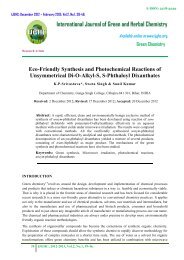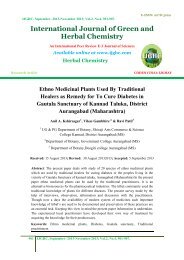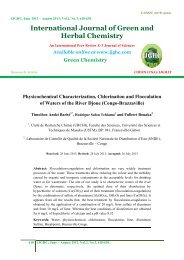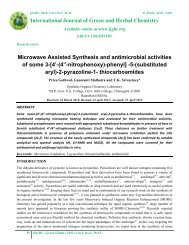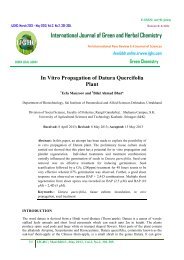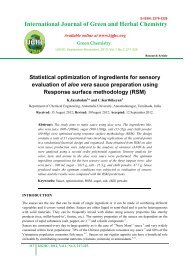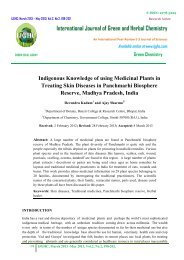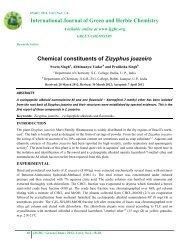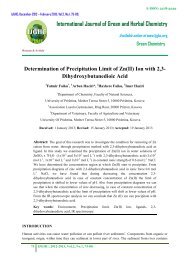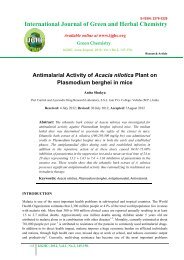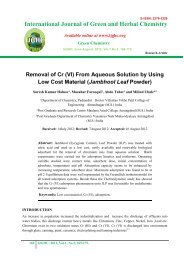Kinetics and mechanism of Phosphotungustic Acid ... - IJGHC
Kinetics and mechanism of Phosphotungustic Acid ... - IJGHC
Kinetics and mechanism of Phosphotungustic Acid ... - IJGHC
You also want an ePaper? Increase the reach of your titles
YUMPU automatically turns print PDFs into web optimized ePapers that Google loves.
<strong>IJGHC</strong>; December 2012 – February 2013; Vol.2, No.1, 91-99.<br />
E-ISSN: 2278-3229<br />
International Journal <strong>of</strong> Green <strong>and</strong> Herbal Chemistry<br />
Research Article<br />
Available online at www.ijghc.org<br />
Green Chemistry<br />
<strong>Kinetics</strong> <strong>and</strong> Mechanism <strong>of</strong> <strong>Phosphotungustic</strong> <strong>Acid</strong><br />
Catalyzed Oxidation <strong>of</strong> p-methyl Benzyl Alcohol by<br />
N-Chlorosaccharin in Acetic <strong>Acid</strong>-Water Medium<br />
H.D. Gupta 1 , S.K. Singh* 1 , Manoj Kumar Solanki 2 , O.P. Gupta 3 <strong>and</strong><br />
Santosh Kumar Singh 4<br />
1 Goverment T.R.S. College, Rewa (M.P.) India.<br />
2 Goverment Engineering, College, Rewa (M.P.) India.<br />
3 Goverment Model science college, Rewa (M.P.) India.<br />
4 Government College, Rampur Naikin, Sidhi (M.P.) India.<br />
Received: 19 December 2012; Revised: 14 January 2013; Accepted: 21 January 2013<br />
Abstract: Kinetic investigations in Keggin-type phosphotungstic acid, which is ec<strong>of</strong>riendly<br />
<strong>and</strong> green catalyst, catalyzed oxidation <strong>of</strong> p-methyl benzyl alcohol by N-<br />
chlorosaccharin, (NCSA) in aqueous acetic acid, have been studied. Oxidation kinetics<br />
<strong>of</strong> p-methyl benzyl alcohol by N-chlorosaccharin in presence <strong>of</strong> Phosphotungstic acid<br />
(PTA) shows a first order dependence on NCSA <strong>and</strong> fractional order on p-methyl<br />
benzyl alcohol <strong>and</strong> PTA. The variation <strong>of</strong> [H + ] <strong>and</strong> [saccharin] (reaction product) have<br />
insignificant effect on reaction rate. Activation parameters for the reaction have been<br />
evaluated from Arrhenius plot by studying the reaction at different temperature. The<br />
rate law has been derived based on obtained kinetics data <strong>and</strong> a plausible <strong>mechanism</strong><br />
has been proposed.<br />
Keywords: <strong>Kinetics</strong>, N-chlorosaccharin, phosphotungstic acid, Keggin anion,<br />
heteropoly acids.<br />
INTRODUCTION<br />
Environmental concern has forced the chemical industry to re-evaluate many <strong>of</strong> its processes to reduce or<br />
eliminate the formation <strong>of</strong> waste produced in the synthesis <strong>of</strong> organic products. This need is specially<br />
required in oxidation technology <strong>and</strong> can be addressed by the development <strong>of</strong> clean <strong>and</strong> safe oxidation<br />
procedures. This is possible by establishment <strong>of</strong> green catalytic process by use <strong>of</strong> environmentally<br />
91 <strong>IJGHC</strong>; 2012-2013, Vol.2, No.1, 91-99.
<strong>Kinetics</strong>...<br />
H.D. Gupta et al.<br />
friendly oxidant or green catalysts. At present we want an ec<strong>of</strong>riendly <strong>and</strong> economic catalyst.<br />
Phosphotungstic acid is a green <strong>and</strong> cheap catalyst. Phosphotungstic acid (PTA) or tungustophosphoric<br />
acid (TPA) is a heteropoly acid with chemical formula H 3 PW 12 O 40 . In the recent years, studies <strong>of</strong><br />
oxidation <strong>of</strong> various organic compounds by heteropoly acids <strong>and</strong> Polyoxometalates especially those with<br />
Keggin type structure under homogeneous <strong>and</strong> heterogeneous reaction conditions 1-9 have attracted<br />
considerable attention <strong>of</strong> the researchers. Literature survey reveals that phosphotungstic acid (PTA) due to<br />
its thermal stability <strong>and</strong> acidity make it efficient <strong>and</strong> eco-friendly catalyst in oxidation <strong>of</strong> organic<br />
compounds, such as aromatic amines 10 , aromatic alcohols 11 , cyclic alcohols 12 , allyl alcohols 13 , oximes 14 ,<br />
styrene 15 etc. The versatile nature <strong>of</strong> N-halo compounds is due to their ability to act as sources <strong>of</strong><br />
halonium ions, hypo halite species <strong>and</strong> nitrogen anions, which act as both bases <strong>and</strong> nucleophiles. They<br />
have been widely used as oxidizing <strong>and</strong> halogenating reagents in organic compounds 16-19 .<br />
N-chlorosaccharin (NCSA) is a potential oxidizing agent <strong>and</strong> has some definite advantages over other<br />
N-halogeno oxidants, which has been extensively used in the estimation <strong>of</strong> organic substrates 20 - 24 . The<br />
kinetics <strong>and</strong> mechanistic investigations <strong>of</strong> the oxidation <strong>of</strong> p-methyl benzyl alcohol by various oxidizing<br />
agents have been studied earlier 25-31 . It seems that there are no reports about PTA catalyzed the kinetics <strong>of</strong><br />
oxidation <strong>of</strong> p-methyl benzyl alcohol by NCSA. The present work reports kinetics <strong>and</strong> <strong>mechanism</strong> <strong>of</strong> PTA<br />
catalyzed oxidation <strong>of</strong> p-methyl benzyl alcohol by N-chlorosaccharin in 30 % acetic acid.<br />
MATERIALS AND METHODS<br />
The oxidant N-chlorosaccharin (Aldrich sample) used. Acetic acid (A.R. grade) purified by the literature<br />
procedure. The st<strong>and</strong>ard solution <strong>of</strong> p-methyl benzyl alcohol (sigma chemicals) was prepared in acetic<br />
acid. Double distilled water employed in all kinetic runs. To prevent photochemical effect, the freshly<br />
prepared solution <strong>of</strong> N-chlorosaccharin was stored in an amber coloured bottle <strong>and</strong> its strength was<br />
checked iodometrically 32 using 1 % solution <strong>of</strong> freshly prepared starch as an indicator.<br />
Kinetic measurements: All kinetic measurements made under pseudo first order conditions, by keeping<br />
large excess <strong>of</strong> p-methyl benzyl alcohol over oxidant N-chlorosaccharin. Mixture containing requisite<br />
amount <strong>of</strong> solutions <strong>of</strong> p-methyl benzyl alcohol, <strong>and</strong> PTA in 30 % acetic acid equilibrated at 313 K. To<br />
this mixture added a measured amount <strong>of</strong> pre-equilibrated (313 K) st<strong>and</strong>ard solution <strong>of</strong> N-chlorosaccharin.<br />
To maintain the desired temperature (within ± 0.1 o C) the reaction mixture was kept in a thermo stated<br />
water bath <strong>and</strong> the progress <strong>of</strong> the reaction was monitored iodometrically by withdrawing aliquots <strong>of</strong> the<br />
reaction mixture at regular time <strong>of</strong> intervals.<br />
Stoichiometry <strong>and</strong> Product Analysis: Stoichiometry <strong>of</strong> the reaction was ascertained by equilibrating the<br />
reaction mixture containing an excess <strong>of</strong> N-chlorosaccharin over p-methyl benzyl alcohol <strong>and</strong><br />
phosphotungstic acid in 30 % acetic acid for 24 hrs. at 313 K. The un-reacted oxidant<br />
(N-chlorosaccharin) was determined by iodometrically. The estimated amount <strong>of</strong> un-reacted<br />
N-chlorosaccharin showed that one mole <strong>of</strong> p-methyl benzyl alcohol consumes one mole <strong>of</strong><br />
N-chlorosaccharin.<br />
92 <strong>IJGHC</strong>; 2012-2013, Vol.2, No.1, 91-99.
<strong>Kinetics</strong>...<br />
H.D. Gupta et al.<br />
The p-methyl benzaldehyde found as the end product <strong>of</strong> oxidation. These products were identified by<br />
forming their 2,4-dinitrophenylhydrazone (p-methyl benzaldehyde 2,4-DNP, M.P. 239.2 0 C ), Which were<br />
characterized by their melting point.<br />
RESULTS AND DISCUSSION<br />
Order on reactants: The kinetics <strong>of</strong> oxidation <strong>of</strong> p-methyl benzyl alcohol by NCSA in 30% acetic acid in<br />
presence <strong>of</strong> phosphotungstic acid (H 3 PW 12 O 40 ) as a catalyst was carried at 313 K under pseudo first order<br />
conditions. The Plot <strong>of</strong> log [NCSA] vs. time found to be linear indicating first order dependence <strong>of</strong> the<br />
reaction rate <strong>and</strong> from the slopes <strong>of</strong> such plots pseudo first order rate evaluated. The rate constant (k’)<br />
have been found to increase with increase in the concentration <strong>of</strong> p-methyl benzyl alcohol <strong>and</strong> plot <strong>of</strong> log<br />
k' Vs log [p-methyl benzyl alcohol] was linear with slope less than unity, indicating a fractional order<br />
dependence on rate <strong>of</strong> p-methyl benzyl alcohol (Table-1). The concentration <strong>of</strong> PTA was varied while the<br />
concentration <strong>of</strong> p-methyl benzyl alcohol <strong>and</strong>, [NCSA] kept constant. Reaction is PTA catalyzed with in a<br />
limit. The plot <strong>of</strong> k 1 vs. [PTA] is obtained linear with the passing through the origin in lower<br />
concentrations but it bent towards x-axis at higher concentrations, indicating fractional order dependence<br />
<strong>of</strong> rate on [PTA] (Fig. 3 , Table 1).<br />
Effect <strong>of</strong> Hydrogen ion: The dependence <strong>of</strong> the reaction rate on hydrogen ion concentration has been<br />
investigated at different initial concentrations <strong>of</strong> H 2 SO 4 <strong>and</strong> keeping the concentration <strong>of</strong> the other<br />
reactants constant. There was no significant change in rate constant observed with variation <strong>of</strong> [H + ] ion.<br />
Effect <strong>of</strong> Ionic Strength: The ionic strength <strong>of</strong> the reaction varied by the addition <strong>of</strong> NaClO 4 <strong>and</strong> the<br />
influence <strong>of</strong> ionic strength on the reaction rate studied. It was found that the ionic strength <strong>of</strong> the reaction<br />
medium has negligible effect on the reaction rate. This may presumably be due to the attack <strong>of</strong> an ion on a<br />
neutral molecule in the rate-determining step.<br />
Effect <strong>of</strong> Solvent Composition: The effect <strong>of</strong> changing solvent composition on the reaction rate was<br />
studied by varying concentration <strong>of</strong> acetic acid from 20-60 %. The rate constants suggest that the rate <strong>of</strong><br />
reaction decreases with increasing acetic acid content <strong>of</strong> the solvent mixture. The plot <strong>of</strong> log k' Vs 1/D<br />
was found to be linear with negative slope indicating the involvement <strong>of</strong> two dipoles or a negative ion–<br />
dipole reaction.<br />
Effect <strong>of</strong> Product <strong>and</strong> Free Radical Inhibitor: Variation <strong>of</strong> saccharin, one <strong>of</strong> the products <strong>of</strong> oxidation,<br />
had negligible effect on the rate <strong>of</strong> reaction. The PTA catalysed oxidation reactions <strong>of</strong> p-methyl benzyl<br />
alcohol with NCSA at different initial concentrations <strong>of</strong> acrylonitrile have been investigated. The reaction<br />
neither induces polymerization nor retards the reaction rate, which may be attributed to the inertness<br />
shown by free radicals.<br />
Reactive Species <strong>and</strong> Mechanism: Earlier reports reveal that NCSA <strong>and</strong> N-chlorosuccinimide are stable<br />
oxidizing <strong>and</strong> chlorinating agents <strong>and</strong> behave in a similar way. NCSA like other similar N-halo imides<br />
may exist in various forms in acid medium viz. free NCSA, protonated NCSA, Cl + , HOCl, H 2 O + Cl. In<br />
absence <strong>of</strong> mineral acid, the possibility <strong>of</strong> Cl + , NCSAH + , or H 2 O + Cl being the reactive oxidizing species is<br />
ruled out. If HOCl is the reactive oxidizing species, then the rate <strong>of</strong> reaction should be an inverse function<br />
<strong>of</strong> saccharin (Sac.) which is not observed in the present study. The rate constants suggest that the rate <strong>of</strong><br />
reaction decreases with increasing acetic acid content <strong>of</strong> the solvent mixture. This observation coupled<br />
with slight enhancement in the reaction rate with ionic strength <strong>of</strong> the medium also supports the<br />
participation <strong>of</strong> neutral molecule in the rate determining step. Therefore (free) NCSA is the probable<br />
oxidizing species under the present experimental condition.<br />
93 <strong>IJGHC</strong>; 2012-2013, Vol.2, No.1, 91-99.
<strong>Kinetics</strong>...<br />
H.D. Gupta et al.<br />
The proton released during the reaction by PTA used for protonation <strong>of</strong> NCSA. Negligible effect <strong>of</strong> [H + ]<br />
suggested that the protonated NCSA is not involved in reaction <strong>mechanism</strong>. Keggin structure <strong>of</strong> PTA<br />
allows the molecule to hydrate <strong>and</strong> dehydrate without significant structural changes. In the present study<br />
the catalyst [PW12O40] 3- Keggin anion gets converted into the oxidized form <strong>and</strong> acts as an outer sphere<br />
reagent. Formation <strong>of</strong> an outer sphere complex by the replacement <strong>of</strong> one <strong>of</strong> the water molecules <strong>of</strong><br />
hydration is more probable transition state. Since probable transition, state is less solvated <strong>and</strong> in large it<br />
will be more stabilized in the medium. Therefore irrespective <strong>of</strong> the nature <strong>of</strong> p-methyl benzyl alcohol the<br />
transition state formed would be the same, making the rate <strong>of</strong> reaction independent <strong>of</strong> nature <strong>of</strong> p-methyl<br />
benzyl alcohol. Oxidation <strong>of</strong> substrate by heteropoly anions occurred via overlap <strong>of</strong> the aromatic system<br />
with the tungstate frame work 33 .<br />
Based upon the experimental observations, the most probable <strong>mechanism</strong> is as following.<br />
The rate <strong>of</strong> reaction may be expressed in terms <strong>of</strong> loss <strong>of</strong> [NCSA] as given below,<br />
(4)<br />
If [NCSA]T =Total concentration <strong>of</strong> [NCSA], then = [NCSA] + [X]<br />
(5)<br />
94 <strong>IJGHC</strong>; 2012-2013, Vol.2, No.1, 91-99.
<strong>Kinetics</strong>...<br />
H.D. Gupta et al.<br />
But, Rate = k[x] according to equation (4), substituting value <strong>of</strong> [X] in it, where [BA] is substrate<br />
Concentration, we have,<br />
(6)<br />
(7)<br />
(8)<br />
The order with respect to [NCSA] is one <strong>and</strong> fractional order with [PTA] <strong>and</strong> [S]. As [BA]>> [NCSA]<br />
Equation (8) further reduced to,<br />
(9)<br />
And,<br />
(10)<br />
At a constant [PTA],<br />
(11)<br />
The ternary complex between oxidant, substrate <strong>and</strong> catalyst strongly evidence by the kinetic results. This<br />
ternary complex has very short lifetime <strong>and</strong> decomposes in rds. Thus, <strong>mechanism</strong> is in good agreement<br />
with the work reported by Binyahia 34 35, 36<br />
<strong>and</strong> Gupta et al.<br />
Effect <strong>of</strong> temperature: The rate <strong>of</strong> oxidation was determined at different temperatures <strong>and</strong> the Arrhenius<br />
plots <strong>of</strong> log k vs. 1/T were all linear From this plot, the activation <strong>and</strong> thermodynamic parameter for<br />
equilibrium step <strong>and</strong> rate determining step <strong>of</strong> the scheme was evaluated (Table 2). The observed DS #<br />
values are large <strong>and</strong> negative. It may be interpreted that the fraction <strong>of</strong> collisions become more stringent<br />
<strong>and</strong> decomposition <strong>of</strong> activation complex is a quite slow process. DH # indicates that the reactions are<br />
enthalpy controlled. Further, the constancy in the calculated values <strong>of</strong> DG # for this oxidation reaction<br />
indicates that the same type <strong>of</strong> the reaction <strong>mechanism</strong> could be operative for the reaction.<br />
95 <strong>IJGHC</strong>; 2012-2013, Vol.2, No.1, 91-99.
<strong>Kinetics</strong>...<br />
H.D. Gupta et al.<br />
CONCLUSION<br />
Kinetic studies demonstrate that the ternary complex <strong>of</strong> Keggin-anion, substrate <strong>and</strong> oxidant decomposes<br />
in a slow rate-determining step to give p-methyl benzaldehyde as the main product. The experimental<br />
stoichiometry is in good agreement. First order to oxidant <strong>and</strong> fractional order to catalyst <strong>and</strong> substrate is<br />
supported by derived rate law. In the present study, Keggin anion acts as an outer sphere electron transfer<br />
reagent. The Keggin-type phosphotungstic acid catalyst is efficient homogeneous catalyst for oxidation <strong>of</strong><br />
p-methyl benzyl alcohol <strong>and</strong> it is participating in the reaction as Keggin anion.<br />
Table- 1: Effect <strong>of</strong> variation <strong>of</strong> reactants on pseudo first-order rate constant k' at 313K<br />
10 2 [Substrate]<br />
(mol dm -3 )<br />
10 3 [NCSA]<br />
(mol dm -3 )<br />
10 3 [H + ]<br />
(mol dm -3 )<br />
10 3 [PTA]<br />
(mol dm -3 )<br />
% HOAc-H 2 O k 1 x10 5<br />
(s -1 )<br />
1.00 2.50 - 1.25 30 11.43<br />
1.25 2.50 - 1.25 30 14.05<br />
2.00 2.50 - 1.25 30 15.82<br />
2.50 2.50 - 1.25 30 16.12<br />
4.00 2.50 - 1.25 30 16.44<br />
1.25 1.00 - 1.25 30 14.33<br />
1.25 2.00 - 1.25 30 14.49<br />
1.25 2.50 - 1.25 30 14.05<br />
1.25 4.00 - 1.25 30 14.13<br />
1.25 5.00 - 1.25 30 14.27<br />
1.25 2.50 1.00 1.25 30 13.87<br />
1.25 2.50 1.25 1.25 30 13.59<br />
1.25 2.50 2.00 1.25 30 13.18<br />
1.25 2.50 2.50 1.25 30 13.00<br />
1.25 2.50 4.00 1.25 30 13.87<br />
1.25 2.50 - 1.00 30 11.43<br />
1.25 2.50 - 1.25 30 14.05<br />
1.25 2.50 - 2.00 30 16.81<br />
1.25 2.50 - 2.50 30 18.52<br />
1.25 2.50 - 4.00 30 20.12<br />
1.25 2.50 - 1.25 20 14.14<br />
1.25 2.50 - 1.25 30 14.05<br />
1.25 2.50 - 1.25 40 13.90<br />
1.25 2.50 - 1.25 50 13.81<br />
1.25 2.50 - 1.25 60 13.75<br />
96 <strong>IJGHC</strong>; 2012-2013, Vol.2, No.1, 91-99.
<strong>Kinetics</strong>...<br />
H.D. Gupta et al.<br />
Table- 2: Thermodynamic parameters <strong>of</strong> p-methyl Benzyl alcohol-NCSA system<br />
Substrate<br />
Ea<br />
(KJ mol -1 )<br />
A<br />
(s -1 )<br />
∆H #<br />
(KJ mol -1 )<br />
∆G #<br />
(KJ mol -1 )<br />
∆S #<br />
(JK mol -1 )<br />
p-methyl Benzyl alcohol<br />
(p-CH 3. BA)<br />
42.03<br />
±0. 66<br />
2.36x10 7<br />
±0.76<br />
47.38<br />
±0.97<br />
-88.68<br />
±0.58<br />
-98.45<br />
±0. 57<br />
[NCSA]=2.50X10 -3 (mol.dm. -3 ), [p-methylBenzyl alcohol] =1.25X10 -2 (mol.dm. -3 ), [PTA] =1.25X 50X10 -3<br />
(mol.dm.-3), HOAC-H 2 O=30% (V/V), Temp. =313K.<br />
Fig.1: Dependence <strong>of</strong> rate on the initial concentration <strong>of</strong> NCSA (oxidant)<br />
97 <strong>IJGHC</strong>; 2012-2013, Vol.2, No.1, 91-99.
<strong>Kinetics</strong>...<br />
H.D. Gupta et al.<br />
[NCSA]=2.50X10 -3 (mol.dm. -3 ), [PTA] =1.25X 50X10 -3 (mol.dm. -3 ), HOAC-H 2 O=30% (V/V), Temp. =313K<br />
. Fig.2: Dependence <strong>of</strong> rate on the concentration <strong>of</strong> Benzyl alcohol (Substrate)<br />
[NCSA]=2.50X10 -3 (mol.dm. -3 ), [p-methyl Benzyl alcohol] =1.25X10 -2 (mol.dm. -3 ), HOAC-H 2 O=30% (V/V),<br />
Temp. =313K.<br />
Fig. 3 Dependence <strong>of</strong> rate on the concentration <strong>of</strong> phosphotungstic acid (PTA)<br />
98 <strong>IJGHC</strong>; 2012-2013, Vol.2, No.1, 91-99.
<strong>Kinetics</strong>...<br />
H.D. Gupta et al.<br />
REFERENCES<br />
1. M. Cindric, Z. Veksli, B. Kamenara, Croat. Chem. Acta., 2009, 82 (2), 345.<br />
2. J. Skrzpek, T. Witczak, M. Grzesik, M. Witczak, Int. J. Chem. Kinet., 2009, 41, 12.<br />
3. A. R. Supale, G. S. Gokavi, React.Kinet.Catal.Lett., 2009, 96 (1) 83.<br />
4. D. B. Bogdanovic, I. H. Anyunovic, M. Todorovic, U. B. Mioc, J. Zakrzewska, J. Serb.Chem. Soc., 2008,<br />
73 (2), 197.<br />
5. P. K. Sapathy, G. C. Das, P. Mohanty, Indian J. Chem., 2008, 47A, 1199.<br />
6. D. S. Rajmane, K. V. Kapshikar, G. S. Gokavi, Indian J. Chem., 2006, 45 A, 1626.<br />
7. P. K. Satpathy, G. C. Dash, S. Acharya, P. Mohanty, J. Indian Chem. Soc., 2006, 83, 891.<br />
8. K. Amani, F. Maleki, J. Iran. Chem. Soc., 2007, 4, 238.<br />
9. S. P. Maradur, G. S. Gokavi, Bull. Catal. Soc. India. 2007, 6, 42.<br />
10. H. Firouzabadi, N. Iranpoor, K. Amani, Green. Chem., 2001, 3, 131.<br />
11. H. Firouzabadi, N. Iranpoor, K. Amani, Synthesis, 2003, 408.<br />
12. J. Bharad, B. Madje, F. Chavan, M. Farooqui, M. Ubale, Bull. Catal. Soc. India., 2008.7,168.<br />
13. L. I. Kuznetsova, R. I. Maksimovskaya, M. A. Fedotov, Inzvestiya Akademii Nauk SSSR.1985, 3, 537.<br />
14. N. Jain, A. Kumar, S. M. S. Chauhan, Tetrahedron Lett., 2005, 46, 2599.<br />
15. P. Sharma, A. Patel, Indian J. Chem., 2009, 48A, 964.<br />
16. A. K. Singh, B. Jain, R. Negi, Y. Katre, S. P. Singh, V. K. Sharma, Transition Met Chem.,2009, 4, 521.<br />
17. D.V. Prabhu, J. Indian Chem. Soc., 2007, 84 (11), 1135.<br />
18. S. Gunasekaran, N. Venkatasubramanian, Proc. Indian Acad. Sci. (Chem. Sci.) 1983, 92(1),107.<br />
19. R. V. Jagdeesh, J. Puttaswamy, Phy. Org. Chem., 2008, 21(10), 844.<br />
20. M. U. Khan; R. K. Tiwari, , J. K. Verma; H. D. Gupta, Oxid.Commun. 1997, 20, 117.<br />
21. Raman Deep Kaur, Monika Arora, Harjeet Gujral, Gurpreet Kaur,S.N.Nayak <strong>and</strong> S.K.Singh. Int.J.<br />
ChemTech Res.2010,2(3)<br />
22. S. Khan, S. K. Nigam, M. U. Khan; H. P. Dwivedi, P. K. Singh Asian J. Chem. 2004, 16, 751.<br />
23. Sanjay K. Singh, Hari D. Gupta, Mohammad U. Khan, Santosh S. Baghel Orbital Elec. J. Chem., Campo<br />
Gr<strong>and</strong>e,2010, 2(2): 118-126,<br />
24. (a) M. U. Khan, S. K Nigam, A. Nigam, J. K.Verma, R. P. S. Chauhan, Oxid. Commun. 1995, 18, 304.;<br />
(b) M. U. Khan.; J. K.Verma, S. S. Parihar, H. P. Dwivedi, Oxid. Commun. 1998, 21, 362.<br />
(c) S. K Nigam, , M. U.Khan, S. Tiwari; H. P. Dwivedi, P. K Singh, Asian J. Chem. 2004, 16, 362<br />
(d) ) M. U. Khan; V. K. Sharma, J. K. Verma, H. P. Dwivedi, Oxid. Commun. 1991, 14, 60.<br />
25. T. D.Radhakrishnan Nair, M. Zuhara, React.Kinet.Catal.Lett., 2009, 96(1), 13.<br />
26. C. Deyrim, B. Emine, M. Ulku, J. Biochem. Engg., 2004, 17(1), 5.<br />
27. K. S. Rangappa, J. Phy.Org. Chem., 2001, 14(10), 684.<br />
28. V. B. Rao, N. A. M. Rao, Indian J. Chem. 2005, 44A (1), 80.<br />
29. H. Ramach<strong>and</strong>ra, K. S. Rangappa, D. S. Mahadevappa, 1998, 9(7), 439.<br />
30. K. Vijayasri, J. Rajaram, J. C. Kuriacose, Proc. Indian Acad. Sci.(Chem. Sci.) 1985, 92(5-6), 573.<br />
31. S.P.Danao, R. T. Thorat, G.D.Nageshwar, Indian Chem.Engr., 2005, 47 A, (3), 156.<br />
32. D. K. Bhat, B. S. Sherigar, B. T. Gowda, Bull. Chem. Soc. Jpn., 1996, 69, 41.<br />
33. A. W. Chester, J. Org. Chem., 1970, 35, 1797.<br />
34. A. R. Binyahia, S. Dubey <strong>and</strong> P. D. Sharma, Oxid. Commun., 2000, 2, 246.<br />
35. H.D. Gupta, S.K. Singh, Santosh Kumar Singh , J. Chem. Bio. Phy. Sci. Sec. A, 2012, 2(.4), 2311.<br />
36. H.D. Gupta, S.K. Singh, Santosh Kumar Singh, J. Chem. Bio. Phy. Sci. Sec. A, 2012, 3(1), 01.<br />
Corresponding author: S.K. Singh;<br />
Govt T.R.S. College, Rewa (M.P.) India<br />
99 <strong>IJGHC</strong>; 2012-2013, Vol.2, No.1, 91-99.



